Central Queensland University: Legal Problem-Solving Toolkit Report
VerifiedAdded on 2022/11/18
|10
|2696
|295
Report
AI Summary
This report examines the legal problem-solving process, drawing parallels to mathematical proofs and emphasizing the importance of legal rules and unspoken principles. It outlines the stages of a legal case, including filing, pleadings exchange, default judgment application, evidence disclosure, pre-trial hearings, and judgment enforcement. The report delves into specific tools, strategies, and theories such as inductive reasoning, exploring methods like concordance and difference, as well as the rule of law and its principles of supremacy, universality, and openness. It also discusses legal positivism, its core tenets, and its implications for understanding the state and law. Finally, it concludes with a reflection on professional development, highlighting the importance of continuous learning and improvement in legal problem-solving skills.
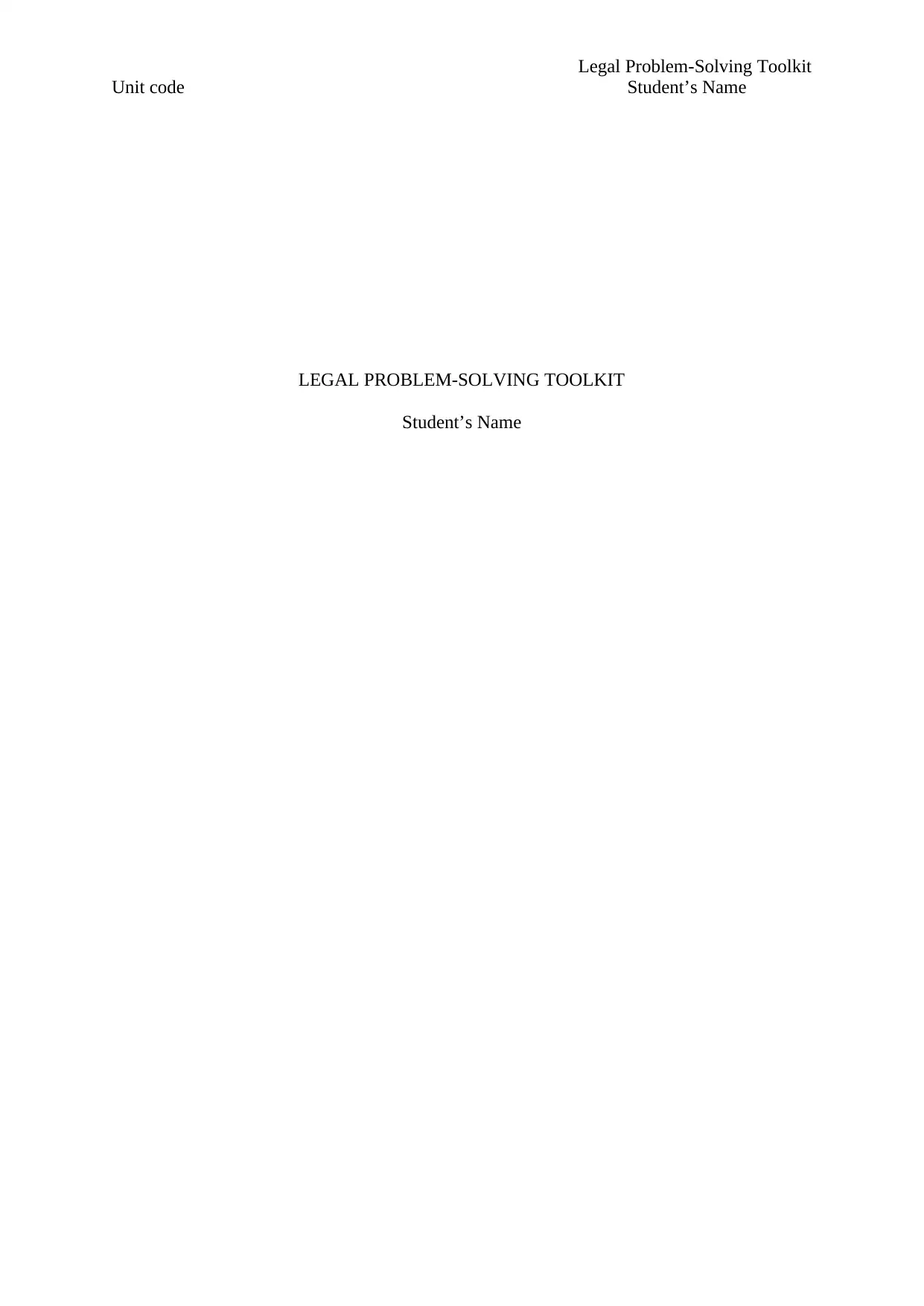
Legal Problem-Solving Toolkit
Unit code Student’s Name
LEGAL PROBLEM-SOLVING TOOLKIT
Student’s Name
Unit code Student’s Name
LEGAL PROBLEM-SOLVING TOOLKIT
Student’s Name
Paraphrase This Document
Need a fresh take? Get an instant paraphrase of this document with our AI Paraphraser

Legal Problem-Solving Toolkit
Unit code Student’s Name
A. Problem Solving Process
The process of lawyers solving legal problems is like solving a mathematical proof.
There may be multiple ways and multiple ways to find a method with the lowest cost and the
fastest speed. It depends on the level of lawyers. Law is like solving the axioms and theorems
in math problems. It is a kind of rule. It is legal to solve the problem and it is legal to be able
to stand up. Mastering the ability to use legal rules is the ability of lawyers to solve
problems1. This ability is different between people, so there is a level of lawyers. In addition
to the rules and regulations of the state, there are still hidden rules for doing things. These can
only be said to be unspeakable. Lawyers must abide by these unspoken rules in the process of
applying legal rules in order to truly get satisfactory results.
The first stage is to file the case. This is when plaintiff file complaint, stating the
reasons for the action and the chief incidents on which it relied. The copy of the bill of charge
and the summons must be sent directly to the defendant.
The second stage is to exchange pleadings. Once the lawsuit is legally filed with the
defendant, the defendant is required to file a notice of litigation participation within the time
limit specified on the summons. If the defendant makes a counterclaim on the defense, the
notice should be accompanied by a counterclaim. The purpose of the pleading exchange is to
clarify the defendant’s objection to the complaint so that both parties can prepare for the
evidence.
The third stage is to apply for default judgment if the defendant fails. If the defendant
fails to submit the notice of litigation participation or the defense of the case within the time
limit, the plaintiff may apply to the court for a default judgment.
1 Willy McCourt, ‘Towards ‘Cognitively Complex’ Problem‐solving: Six Models of Public Service Reform,’
(2018) (36) Development Policy Review: O748–68.
Unit code Student’s Name
A. Problem Solving Process
The process of lawyers solving legal problems is like solving a mathematical proof.
There may be multiple ways and multiple ways to find a method with the lowest cost and the
fastest speed. It depends on the level of lawyers. Law is like solving the axioms and theorems
in math problems. It is a kind of rule. It is legal to solve the problem and it is legal to be able
to stand up. Mastering the ability to use legal rules is the ability of lawyers to solve
problems1. This ability is different between people, so there is a level of lawyers. In addition
to the rules and regulations of the state, there are still hidden rules for doing things. These can
only be said to be unspeakable. Lawyers must abide by these unspoken rules in the process of
applying legal rules in order to truly get satisfactory results.
The first stage is to file the case. This is when plaintiff file complaint, stating the
reasons for the action and the chief incidents on which it relied. The copy of the bill of charge
and the summons must be sent directly to the defendant.
The second stage is to exchange pleadings. Once the lawsuit is legally filed with the
defendant, the defendant is required to file a notice of litigation participation within the time
limit specified on the summons. If the defendant makes a counterclaim on the defense, the
notice should be accompanied by a counterclaim. The purpose of the pleading exchange is to
clarify the defendant’s objection to the complaint so that both parties can prepare for the
evidence.
The third stage is to apply for default judgment if the defendant fails. If the defendant
fails to submit the notice of litigation participation or the defense of the case within the time
limit, the plaintiff may apply to the court for a default judgment.
1 Willy McCourt, ‘Towards ‘Cognitively Complex’ Problem‐solving: Six Models of Public Service Reform,’
(2018) (36) Development Policy Review: O748–68.
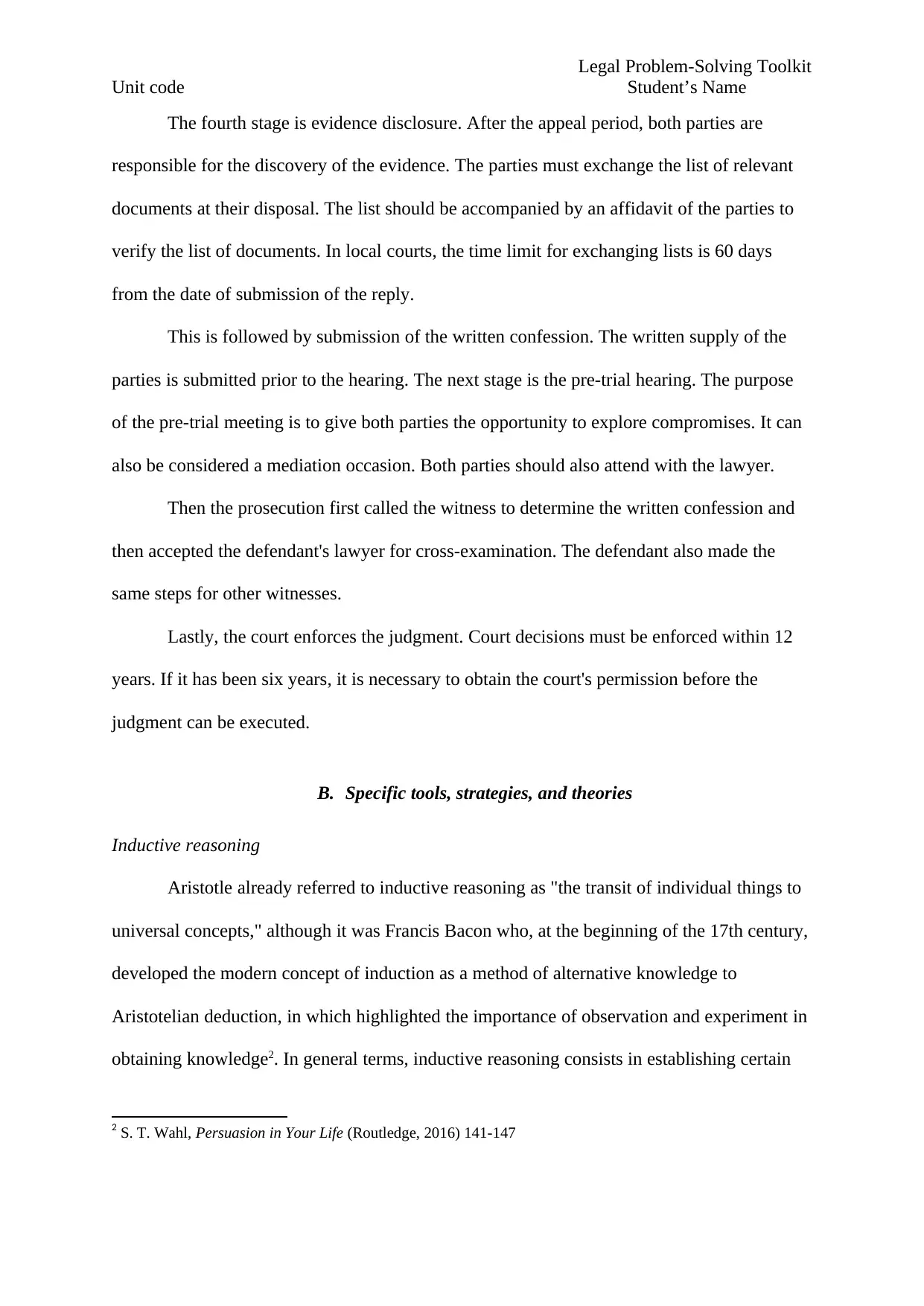
Legal Problem-Solving Toolkit
Unit code Student’s Name
The fourth stage is evidence disclosure. After the appeal period, both parties are
responsible for the discovery of the evidence. The parties must exchange the list of relevant
documents at their disposal. The list should be accompanied by an affidavit of the parties to
verify the list of documents. In local courts, the time limit for exchanging lists is 60 days
from the date of submission of the reply.
This is followed by submission of the written confession. The written supply of the
parties is submitted prior to the hearing. The next stage is the pre-trial hearing. The purpose
of the pre-trial meeting is to give both parties the opportunity to explore compromises. It can
also be considered a mediation occasion. Both parties should also attend with the lawyer.
Then the prosecution first called the witness to determine the written confession and
then accepted the defendant's lawyer for cross-examination. The defendant also made the
same steps for other witnesses.
Lastly, the court enforces the judgment. Court decisions must be enforced within 12
years. If it has been six years, it is necessary to obtain the court's permission before the
judgment can be executed.
B. Specific tools, strategies, and theories
Inductive reasoning
Aristotle already referred to inductive reasoning as "the transit of individual things to
universal concepts," although it was Francis Bacon who, at the beginning of the 17th century,
developed the modern concept of induction as a method of alternative knowledge to
Aristotelian deduction, in which highlighted the importance of observation and experiment in
obtaining knowledge2. In general terms, inductive reasoning consists in establishing certain
2 S. T. Wahl, Persuasion in Your Life (Routledge, 2016) 141-147
Unit code Student’s Name
The fourth stage is evidence disclosure. After the appeal period, both parties are
responsible for the discovery of the evidence. The parties must exchange the list of relevant
documents at their disposal. The list should be accompanied by an affidavit of the parties to
verify the list of documents. In local courts, the time limit for exchanging lists is 60 days
from the date of submission of the reply.
This is followed by submission of the written confession. The written supply of the
parties is submitted prior to the hearing. The next stage is the pre-trial hearing. The purpose
of the pre-trial meeting is to give both parties the opportunity to explore compromises. It can
also be considered a mediation occasion. Both parties should also attend with the lawyer.
Then the prosecution first called the witness to determine the written confession and
then accepted the defendant's lawyer for cross-examination. The defendant also made the
same steps for other witnesses.
Lastly, the court enforces the judgment. Court decisions must be enforced within 12
years. If it has been six years, it is necessary to obtain the court's permission before the
judgment can be executed.
B. Specific tools, strategies, and theories
Inductive reasoning
Aristotle already referred to inductive reasoning as "the transit of individual things to
universal concepts," although it was Francis Bacon who, at the beginning of the 17th century,
developed the modern concept of induction as a method of alternative knowledge to
Aristotelian deduction, in which highlighted the importance of observation and experiment in
obtaining knowledge2. In general terms, inductive reasoning consists in establishing certain
2 S. T. Wahl, Persuasion in Your Life (Routledge, 2016) 141-147
⊘ This is a preview!⊘
Do you want full access?
Subscribe today to unlock all pages.

Trusted by 1+ million students worldwide

Legal Problem-Solving Toolkit
Unit code Student’s Name
universal statements from experience, that is, ascending logically through scientific
knowledge, from the observation of the phenomena or facts of reality to the universal law that
contains them. John S. Mill, in his essay A System of Logic, Ratiocinative and Inductive,
proposed five methods or canons in inductive reasoning. The first method is the concordance
method. If a single circumstance is found in common among the cases under investigation, it
can be induced that this circumstance is the cause of the phenomenon. For example, if in two
different factories, a new protocol is introduced, and in both, the results are improved, the
cause will be that new procedure. The second method is the difference method. If a
circumstance among several equals is what distinguishes the rest of the cases, then that
circumstance is the cause of the phenomenon. For example, if workers who have received
professional training have higher rates of job satisfaction than those who do not, that training
is the cause of their motivation. There is also waste method. It consists of eliminating certain
circumstances and observing if the phenomenon persists. Thus, the corporate website suffers
a high bounce rate, so the developer begins to make modifications, such as removing pop-
ups, simplifying the design, organizing the contents ... until you see what change improves
the results. There is also a concomitant variations method. It is based on observing the
variations of the phenomenon and discovering what other phenomenon varies concomitantly.
If found, that may be the cause of the phenomenon studied. For example, when there is a
replacement of a professional in a team, its performance decreases during a period. It should
be noted that in the formulation of these universal laws it is based on a probability of the facts
and it will be necessary to verify, through research, that it really occurs in all cases, reaching
the so-called 'perfect induction,' that is, that all metals really melt with heat. Thus, the more
premises are empirically corroborated, the more likely it is that the conjecture is true.
Rule of Law
Unit code Student’s Name
universal statements from experience, that is, ascending logically through scientific
knowledge, from the observation of the phenomena or facts of reality to the universal law that
contains them. John S. Mill, in his essay A System of Logic, Ratiocinative and Inductive,
proposed five methods or canons in inductive reasoning. The first method is the concordance
method. If a single circumstance is found in common among the cases under investigation, it
can be induced that this circumstance is the cause of the phenomenon. For example, if in two
different factories, a new protocol is introduced, and in both, the results are improved, the
cause will be that new procedure. The second method is the difference method. If a
circumstance among several equals is what distinguishes the rest of the cases, then that
circumstance is the cause of the phenomenon. For example, if workers who have received
professional training have higher rates of job satisfaction than those who do not, that training
is the cause of their motivation. There is also waste method. It consists of eliminating certain
circumstances and observing if the phenomenon persists. Thus, the corporate website suffers
a high bounce rate, so the developer begins to make modifications, such as removing pop-
ups, simplifying the design, organizing the contents ... until you see what change improves
the results. There is also a concomitant variations method. It is based on observing the
variations of the phenomenon and discovering what other phenomenon varies concomitantly.
If found, that may be the cause of the phenomenon studied. For example, when there is a
replacement of a professional in a team, its performance decreases during a period. It should
be noted that in the formulation of these universal laws it is based on a probability of the facts
and it will be necessary to verify, through research, that it really occurs in all cases, reaching
the so-called 'perfect induction,' that is, that all metals really melt with heat. Thus, the more
premises are empirically corroborated, the more likely it is that the conjecture is true.
Rule of Law
Paraphrase This Document
Need a fresh take? Get an instant paraphrase of this document with our AI Paraphraser
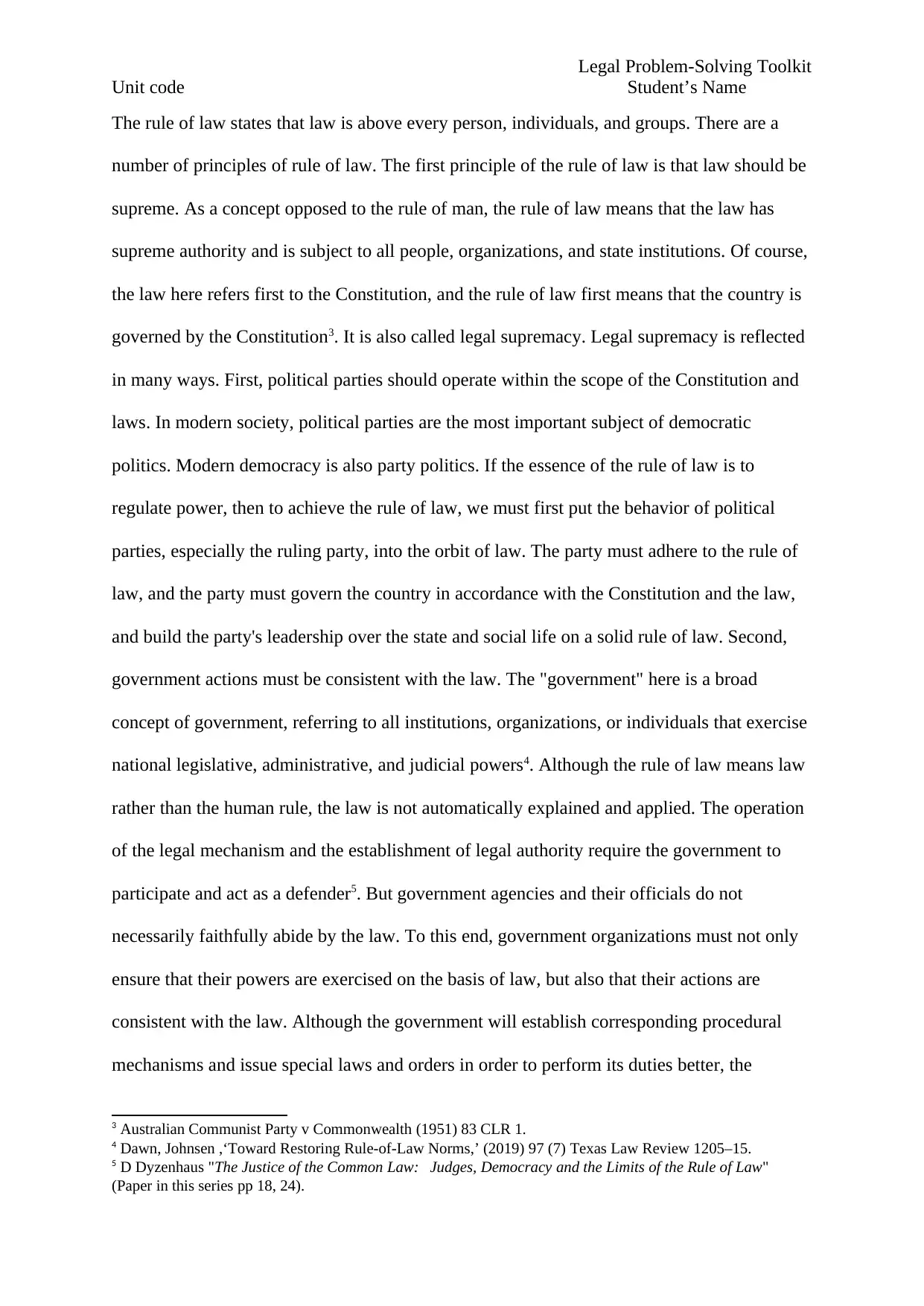
Legal Problem-Solving Toolkit
Unit code Student’s Name
The rule of law states that law is above every person, individuals, and groups. There are a
number of principles of rule of law. The first principle of the rule of law is that law should be
supreme. As a concept opposed to the rule of man, the rule of law means that the law has
supreme authority and is subject to all people, organizations, and state institutions. Of course,
the law here refers first to the Constitution, and the rule of law first means that the country is
governed by the Constitution3. It is also called legal supremacy. Legal supremacy is reflected
in many ways. First, political parties should operate within the scope of the Constitution and
laws. In modern society, political parties are the most important subject of democratic
politics. Modern democracy is also party politics. If the essence of the rule of law is to
regulate power, then to achieve the rule of law, we must first put the behavior of political
parties, especially the ruling party, into the orbit of law. The party must adhere to the rule of
law, and the party must govern the country in accordance with the Constitution and the law,
and build the party's leadership over the state and social life on a solid rule of law. Second,
government actions must be consistent with the law. The "government" here is a broad
concept of government, referring to all institutions, organizations, or individuals that exercise
national legislative, administrative, and judicial powers4. Although the rule of law means law
rather than the human rule, the law is not automatically explained and applied. The operation
of the legal mechanism and the establishment of legal authority require the government to
participate and act as a defender5. But government agencies and their officials do not
necessarily faithfully abide by the law. To this end, government organizations must not only
ensure that their powers are exercised on the basis of law, but also that their actions are
consistent with the law. Although the government will establish corresponding procedural
mechanisms and issue special laws and orders in order to perform its duties better, the
3 Australian Communist Party v Commonwealth (1951) 83 CLR 1.
4 Dawn, Johnsen ,‘Toward Restoring Rule-of-Law Norms,’ (2019) 97 (7) Texas Law Review 1205–15.
5 D Dyzenhaus "The Justice of the Common Law: Judges, Democracy and the Limits of the Rule of Law"
(Paper in this series pp 18, 24).
Unit code Student’s Name
The rule of law states that law is above every person, individuals, and groups. There are a
number of principles of rule of law. The first principle of the rule of law is that law should be
supreme. As a concept opposed to the rule of man, the rule of law means that the law has
supreme authority and is subject to all people, organizations, and state institutions. Of course,
the law here refers first to the Constitution, and the rule of law first means that the country is
governed by the Constitution3. It is also called legal supremacy. Legal supremacy is reflected
in many ways. First, political parties should operate within the scope of the Constitution and
laws. In modern society, political parties are the most important subject of democratic
politics. Modern democracy is also party politics. If the essence of the rule of law is to
regulate power, then to achieve the rule of law, we must first put the behavior of political
parties, especially the ruling party, into the orbit of law. The party must adhere to the rule of
law, and the party must govern the country in accordance with the Constitution and the law,
and build the party's leadership over the state and social life on a solid rule of law. Second,
government actions must be consistent with the law. The "government" here is a broad
concept of government, referring to all institutions, organizations, or individuals that exercise
national legislative, administrative, and judicial powers4. Although the rule of law means law
rather than the human rule, the law is not automatically explained and applied. The operation
of the legal mechanism and the establishment of legal authority require the government to
participate and act as a defender5. But government agencies and their officials do not
necessarily faithfully abide by the law. To this end, government organizations must not only
ensure that their powers are exercised on the basis of law, but also that their actions are
consistent with the law. Although the government will establish corresponding procedural
mechanisms and issue special laws and orders in order to perform its duties better, the
3 Australian Communist Party v Commonwealth (1951) 83 CLR 1.
4 Dawn, Johnsen ,‘Toward Restoring Rule-of-Law Norms,’ (2019) 97 (7) Texas Law Review 1205–15.
5 D Dyzenhaus "The Justice of the Common Law: Judges, Democracy and the Limits of the Rule of Law"
(Paper in this series pp 18, 24).
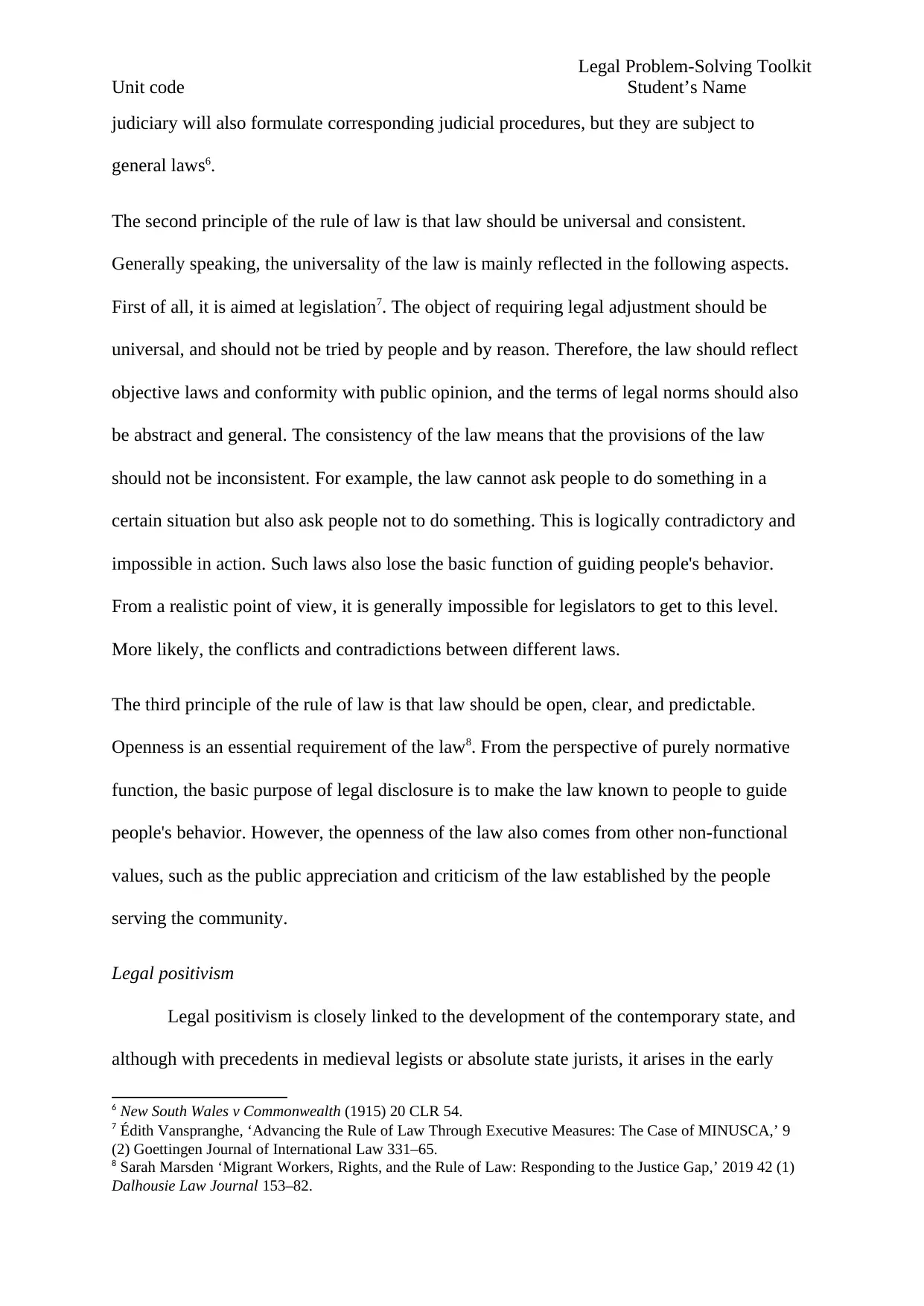
Legal Problem-Solving Toolkit
Unit code Student’s Name
judiciary will also formulate corresponding judicial procedures, but they are subject to
general laws6.
The second principle of the rule of law is that law should be universal and consistent.
Generally speaking, the universality of the law is mainly reflected in the following aspects.
First of all, it is aimed at legislation7. The object of requiring legal adjustment should be
universal, and should not be tried by people and by reason. Therefore, the law should reflect
objective laws and conformity with public opinion, and the terms of legal norms should also
be abstract and general. The consistency of the law means that the provisions of the law
should not be inconsistent. For example, the law cannot ask people to do something in a
certain situation but also ask people not to do something. This is logically contradictory and
impossible in action. Such laws also lose the basic function of guiding people's behavior.
From a realistic point of view, it is generally impossible for legislators to get to this level.
More likely, the conflicts and contradictions between different laws.
The third principle of the rule of law is that law should be open, clear, and predictable.
Openness is an essential requirement of the law8. From the perspective of purely normative
function, the basic purpose of legal disclosure is to make the law known to people to guide
people's behavior. However, the openness of the law also comes from other non-functional
values, such as the public appreciation and criticism of the law established by the people
serving the community.
Legal positivism
Legal positivism is closely linked to the development of the contemporary state, and
although with precedents in medieval legists or absolute state jurists, it arises in the early
6 New South Wales v Commonwealth (1915) 20 CLR 54.
7 Édith Vanspranghe, ‘Advancing the Rule of Law Through Executive Measures: The Case of MINUSCA,’ 9
(2) Goettingen Journal of International Law 331–65.
8 Sarah Marsden ‘Migrant Workers, Rights, and the Rule of Law: Responding to the Justice Gap,’ 2019 42 (1)
Dalhousie Law Journal 153–82.
Unit code Student’s Name
judiciary will also formulate corresponding judicial procedures, but they are subject to
general laws6.
The second principle of the rule of law is that law should be universal and consistent.
Generally speaking, the universality of the law is mainly reflected in the following aspects.
First of all, it is aimed at legislation7. The object of requiring legal adjustment should be
universal, and should not be tried by people and by reason. Therefore, the law should reflect
objective laws and conformity with public opinion, and the terms of legal norms should also
be abstract and general. The consistency of the law means that the provisions of the law
should not be inconsistent. For example, the law cannot ask people to do something in a
certain situation but also ask people not to do something. This is logically contradictory and
impossible in action. Such laws also lose the basic function of guiding people's behavior.
From a realistic point of view, it is generally impossible for legislators to get to this level.
More likely, the conflicts and contradictions between different laws.
The third principle of the rule of law is that law should be open, clear, and predictable.
Openness is an essential requirement of the law8. From the perspective of purely normative
function, the basic purpose of legal disclosure is to make the law known to people to guide
people's behavior. However, the openness of the law also comes from other non-functional
values, such as the public appreciation and criticism of the law established by the people
serving the community.
Legal positivism
Legal positivism is closely linked to the development of the contemporary state, and
although with precedents in medieval legists or absolute state jurists, it arises in the early
6 New South Wales v Commonwealth (1915) 20 CLR 54.
7 Édith Vanspranghe, ‘Advancing the Rule of Law Through Executive Measures: The Case of MINUSCA,’ 9
(2) Goettingen Journal of International Law 331–65.
8 Sarah Marsden ‘Migrant Workers, Rights, and the Rule of Law: Responding to the Justice Gap,’ 2019 42 (1)
Dalhousie Law Journal 153–82.
⊘ This is a preview!⊘
Do you want full access?
Subscribe today to unlock all pages.

Trusted by 1+ million students worldwide
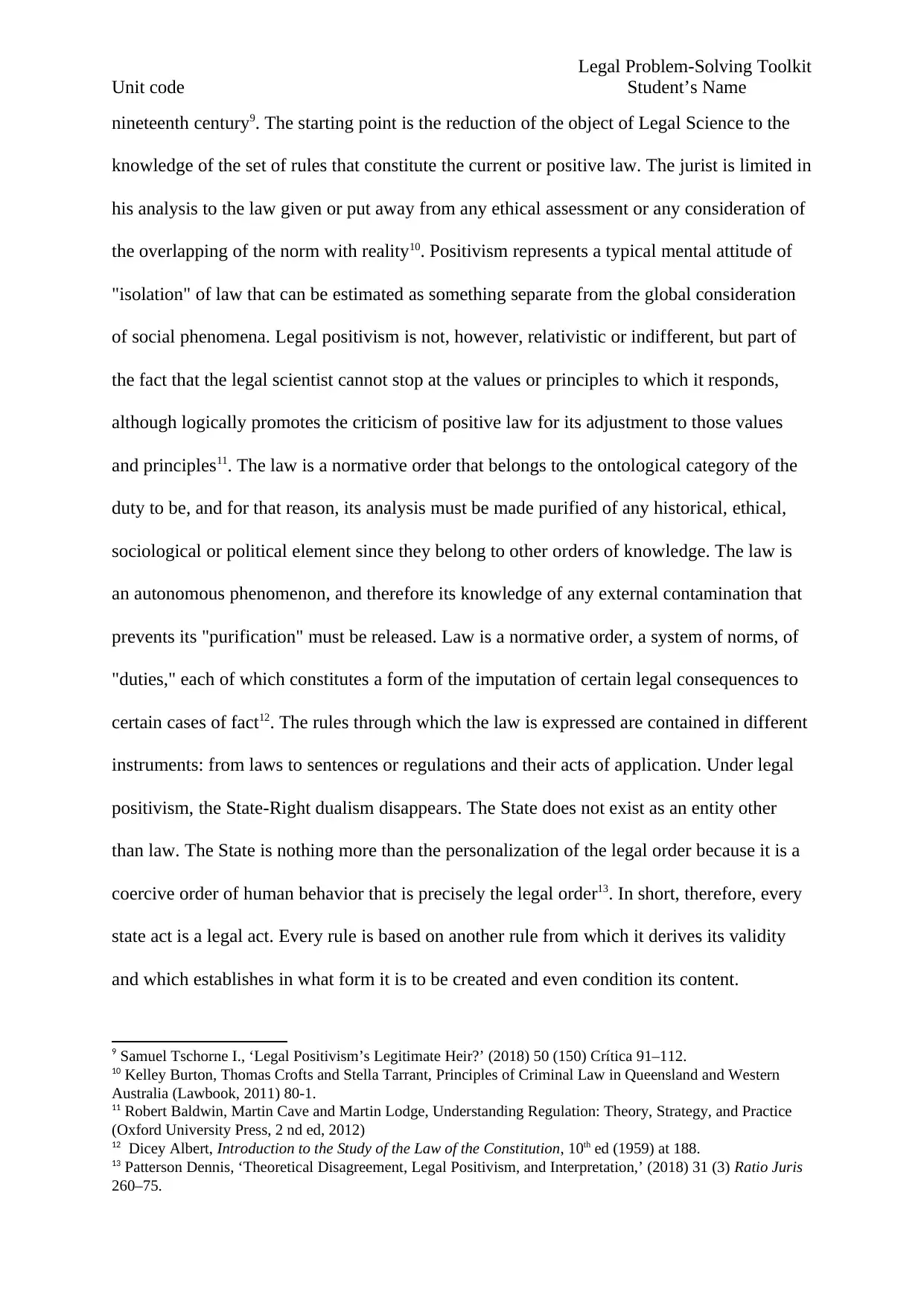
Legal Problem-Solving Toolkit
Unit code Student’s Name
nineteenth century9. The starting point is the reduction of the object of Legal Science to the
knowledge of the set of rules that constitute the current or positive law. The jurist is limited in
his analysis to the law given or put away from any ethical assessment or any consideration of
the overlapping of the norm with reality10. Positivism represents a typical mental attitude of
"isolation" of law that can be estimated as something separate from the global consideration
of social phenomena. Legal positivism is not, however, relativistic or indifferent, but part of
the fact that the legal scientist cannot stop at the values or principles to which it responds,
although logically promotes the criticism of positive law for its adjustment to those values
and principles11. The law is a normative order that belongs to the ontological category of the
duty to be, and for that reason, its analysis must be made purified of any historical, ethical,
sociological or political element since they belong to other orders of knowledge. The law is
an autonomous phenomenon, and therefore its knowledge of any external contamination that
prevents its "purification" must be released. Law is a normative order, a system of norms, of
"duties," each of which constitutes a form of the imputation of certain legal consequences to
certain cases of fact12. The rules through which the law is expressed are contained in different
instruments: from laws to sentences or regulations and their acts of application. Under legal
positivism, the State-Right dualism disappears. The State does not exist as an entity other
than law. The State is nothing more than the personalization of the legal order because it is a
coercive order of human behavior that is precisely the legal order13. In short, therefore, every
state act is a legal act. Every rule is based on another rule from which it derives its validity
and which establishes in what form it is to be created and even condition its content.
9 Samuel Tschorne I., ‘Legal Positivism’s Legitimate Heir?’ (2018) 50 (150) Crítica 91–112.
10 Kelley Burton, Thomas Crofts and Stella Tarrant, Principles of Criminal Law in Queensland and Western
Australia (Lawbook, 2011) 80-1.
11 Robert Baldwin, Martin Cave and Martin Lodge, Understanding Regulation: Theory, Strategy, and Practice
(Oxford University Press, 2 nd ed, 2012)
12 Dicey Albert, Introduction to the Study of the Law of the Constitution, 10th ed (1959) at 188.
13 Patterson Dennis, ‘Theoretical Disagreement, Legal Positivism, and Interpretation,’ (2018) 31 (3) Ratio Juris
260–75.
Unit code Student’s Name
nineteenth century9. The starting point is the reduction of the object of Legal Science to the
knowledge of the set of rules that constitute the current or positive law. The jurist is limited in
his analysis to the law given or put away from any ethical assessment or any consideration of
the overlapping of the norm with reality10. Positivism represents a typical mental attitude of
"isolation" of law that can be estimated as something separate from the global consideration
of social phenomena. Legal positivism is not, however, relativistic or indifferent, but part of
the fact that the legal scientist cannot stop at the values or principles to which it responds,
although logically promotes the criticism of positive law for its adjustment to those values
and principles11. The law is a normative order that belongs to the ontological category of the
duty to be, and for that reason, its analysis must be made purified of any historical, ethical,
sociological or political element since they belong to other orders of knowledge. The law is
an autonomous phenomenon, and therefore its knowledge of any external contamination that
prevents its "purification" must be released. Law is a normative order, a system of norms, of
"duties," each of which constitutes a form of the imputation of certain legal consequences to
certain cases of fact12. The rules through which the law is expressed are contained in different
instruments: from laws to sentences or regulations and their acts of application. Under legal
positivism, the State-Right dualism disappears. The State does not exist as an entity other
than law. The State is nothing more than the personalization of the legal order because it is a
coercive order of human behavior that is precisely the legal order13. In short, therefore, every
state act is a legal act. Every rule is based on another rule from which it derives its validity
and which establishes in what form it is to be created and even condition its content.
9 Samuel Tschorne I., ‘Legal Positivism’s Legitimate Heir?’ (2018) 50 (150) Crítica 91–112.
10 Kelley Burton, Thomas Crofts and Stella Tarrant, Principles of Criminal Law in Queensland and Western
Australia (Lawbook, 2011) 80-1.
11 Robert Baldwin, Martin Cave and Martin Lodge, Understanding Regulation: Theory, Strategy, and Practice
(Oxford University Press, 2 nd ed, 2012)
12 Dicey Albert, Introduction to the Study of the Law of the Constitution, 10th ed (1959) at 188.
13 Patterson Dennis, ‘Theoretical Disagreement, Legal Positivism, and Interpretation,’ (2018) 31 (3) Ratio Juris
260–75.
Paraphrase This Document
Need a fresh take? Get an instant paraphrase of this document with our AI Paraphraser

Legal Problem-Solving Toolkit
Unit code Student’s Name
C. Reflection on Professional Development
I plan to do more research on law so that I can understand all laws in and out because
lack of understanding of law is dangerous to my profession. So far, I have learned that when
applying the law, the law-applicable authority shall not treat the citizen differently because of
the nationality, race, gender, occupation, family origin, religious belief, education level,
property status, and residence period. For example, in the field of administrative law
enforcement, in the face of the same illegal acts, the administrative organs should not
selectively enforce the law, investigate the illegal acts of some people, and turn a blind eye to
the illegal acts of others, and do not pursue them. Consequently, a good lawyer or judge
should understand not only state and federal laws but also international laws. It is therefore
my plan to read and study widely on different laws and how they are applied.
I also plan to improve my level of autonomy, confidence and independence in law because I
have learned that judicial trial activities should be loyal to the law and not subject to
government, public opinion, etc., whether it is to accept disputes between private parties or
the government and the general public.
Unit code Student’s Name
C. Reflection on Professional Development
I plan to do more research on law so that I can understand all laws in and out because
lack of understanding of law is dangerous to my profession. So far, I have learned that when
applying the law, the law-applicable authority shall not treat the citizen differently because of
the nationality, race, gender, occupation, family origin, religious belief, education level,
property status, and residence period. For example, in the field of administrative law
enforcement, in the face of the same illegal acts, the administrative organs should not
selectively enforce the law, investigate the illegal acts of some people, and turn a blind eye to
the illegal acts of others, and do not pursue them. Consequently, a good lawyer or judge
should understand not only state and federal laws but also international laws. It is therefore
my plan to read and study widely on different laws and how they are applied.
I also plan to improve my level of autonomy, confidence and independence in law because I
have learned that judicial trial activities should be loyal to the law and not subject to
government, public opinion, etc., whether it is to accept disputes between private parties or
the government and the general public.
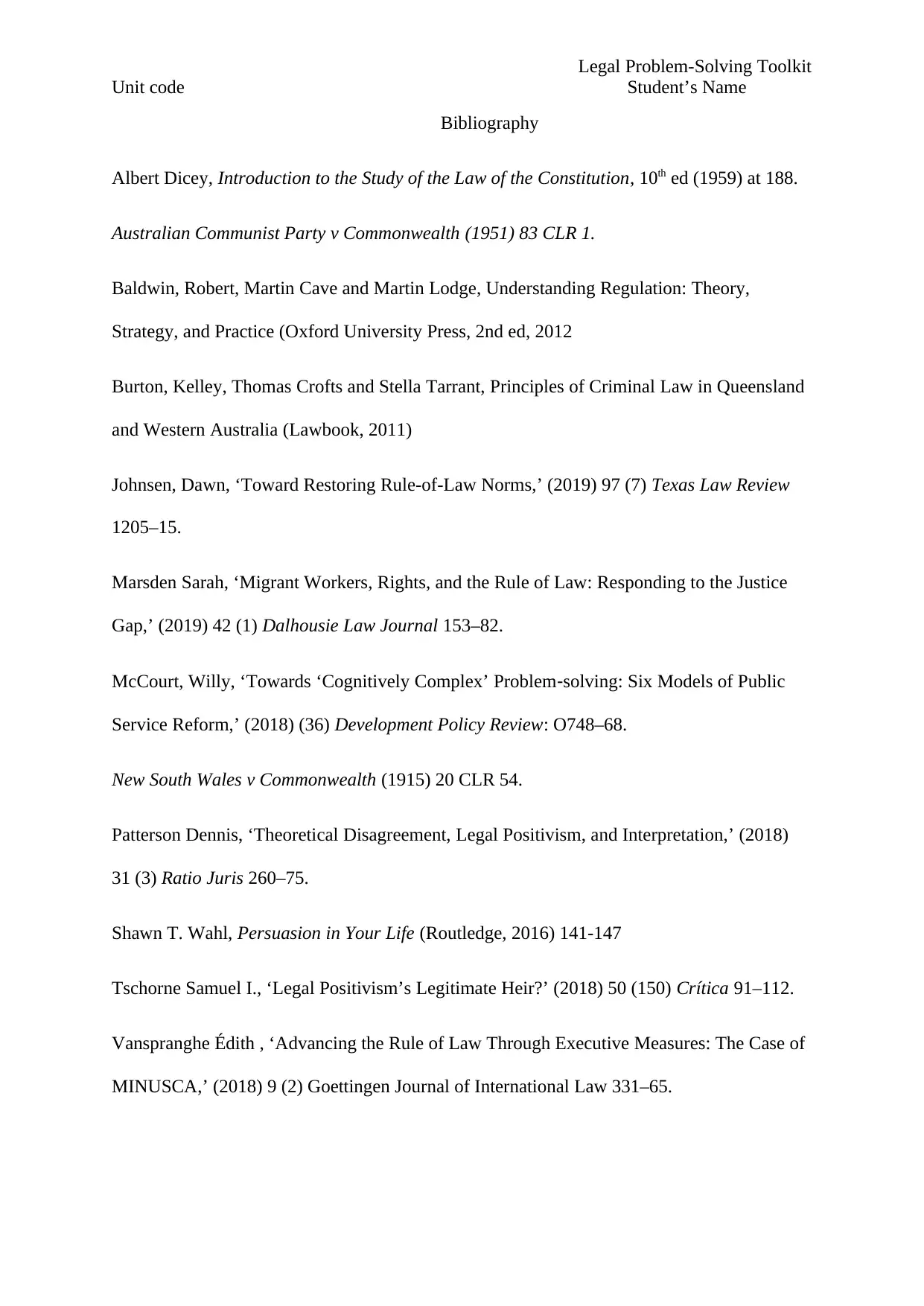
Legal Problem-Solving Toolkit
Unit code Student’s Name
Bibliography
Albert Dicey, Introduction to the Study of the Law of the Constitution, 10th ed (1959) at 188.
Australian Communist Party v Commonwealth (1951) 83 CLR 1.
Baldwin, Robert, Martin Cave and Martin Lodge, Understanding Regulation: Theory,
Strategy, and Practice (Oxford University Press, 2nd ed, 2012
Burton, Kelley, Thomas Crofts and Stella Tarrant, Principles of Criminal Law in Queensland
and Western Australia (Lawbook, 2011)
Johnsen, Dawn, ‘Toward Restoring Rule-of-Law Norms,’ (2019) 97 (7) Texas Law Review
1205–15.
Marsden Sarah, ‘Migrant Workers, Rights, and the Rule of Law: Responding to the Justice
Gap,’ (2019) 42 (1) Dalhousie Law Journal 153–82.
McCourt, Willy, ‘Towards ‘Cognitively Complex’ Problem‐solving: Six Models of Public
Service Reform,’ (2018) (36) Development Policy Review: O748–68.
New South Wales v Commonwealth (1915) 20 CLR 54.
Patterson Dennis, ‘Theoretical Disagreement, Legal Positivism, and Interpretation,’ (2018)
31 (3) Ratio Juris 260–75.
Shawn T. Wahl, Persuasion in Your Life (Routledge, 2016) 141-147
Tschorne Samuel I., ‘Legal Positivism’s Legitimate Heir?’ (2018) 50 (150) Crítica 91–112.
Vanspranghe Édith , ‘Advancing the Rule of Law Through Executive Measures: The Case of
MINUSCA,’ (2018) 9 (2) Goettingen Journal of International Law 331–65.
Unit code Student’s Name
Bibliography
Albert Dicey, Introduction to the Study of the Law of the Constitution, 10th ed (1959) at 188.
Australian Communist Party v Commonwealth (1951) 83 CLR 1.
Baldwin, Robert, Martin Cave and Martin Lodge, Understanding Regulation: Theory,
Strategy, and Practice (Oxford University Press, 2nd ed, 2012
Burton, Kelley, Thomas Crofts and Stella Tarrant, Principles of Criminal Law in Queensland
and Western Australia (Lawbook, 2011)
Johnsen, Dawn, ‘Toward Restoring Rule-of-Law Norms,’ (2019) 97 (7) Texas Law Review
1205–15.
Marsden Sarah, ‘Migrant Workers, Rights, and the Rule of Law: Responding to the Justice
Gap,’ (2019) 42 (1) Dalhousie Law Journal 153–82.
McCourt, Willy, ‘Towards ‘Cognitively Complex’ Problem‐solving: Six Models of Public
Service Reform,’ (2018) (36) Development Policy Review: O748–68.
New South Wales v Commonwealth (1915) 20 CLR 54.
Patterson Dennis, ‘Theoretical Disagreement, Legal Positivism, and Interpretation,’ (2018)
31 (3) Ratio Juris 260–75.
Shawn T. Wahl, Persuasion in Your Life (Routledge, 2016) 141-147
Tschorne Samuel I., ‘Legal Positivism’s Legitimate Heir?’ (2018) 50 (150) Crítica 91–112.
Vanspranghe Édith , ‘Advancing the Rule of Law Through Executive Measures: The Case of
MINUSCA,’ (2018) 9 (2) Goettingen Journal of International Law 331–65.
⊘ This is a preview!⊘
Do you want full access?
Subscribe today to unlock all pages.

Trusted by 1+ million students worldwide

Legal Problem-Solving Toolkit
Unit code Student’s Name
Nouman, Muhammad, Alistair Anderson, and Fahad Abdullah, ‘Conceptualizing and
Rationalizing Opportunities: Inductive Reasoning and the Creation of a New Enterprise,’
(2018) Abasyn University Journal of Social Sciences, July, 1–20.
Unit code Student’s Name
Nouman, Muhammad, Alistair Anderson, and Fahad Abdullah, ‘Conceptualizing and
Rationalizing Opportunities: Inductive Reasoning and the Creation of a New Enterprise,’
(2018) Abasyn University Journal of Social Sciences, July, 1–20.
1 out of 10
Your All-in-One AI-Powered Toolkit for Academic Success.
+13062052269
info@desklib.com
Available 24*7 on WhatsApp / Email
![[object Object]](/_next/static/media/star-bottom.7253800d.svg)
Unlock your academic potential
Copyright © 2020–2025 A2Z Services. All Rights Reserved. Developed and managed by ZUCOL.